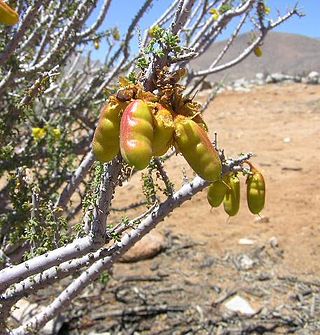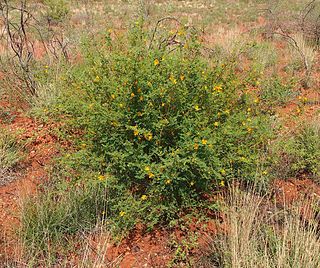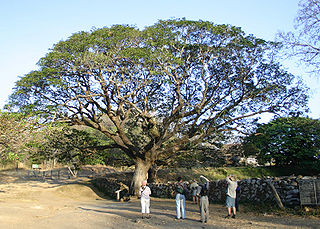
The Mimosoideae are a traditional subfamily of trees, herbs, lianas, and shrubs in the pea family (Fabaceae) that mostly grow in tropical and subtropical climates. They are typically characterized by having radially symmetric flowers, with petals that are twice divided (valvate) in bud and with numerous showy, prominent stamens.

The Fabaceae or Leguminosae, commonly known as the legume, pea, or bean family, are a large and agriculturally important family of flowering plants. It includes trees, shrubs, and perennial or annual herbaceous plants, which are easily recognized by their fruit (legume) and their compound, stipulate leaves. The family is widely distributed, and is the third-largest land plant family in number of species, behind only the Orchidaceae and Asteraceae, with about 765 genera and nearly 20,000 known species.

The subfamily Detarioideae is one of the subdivisions of the plant family Fabaceae (legumes). This subfamily includes many tropical trees, some of which are used for timber or have ecological importance. The subfamily consists of 84 genera, most of which are native to Africa and Asia. Pride of Burma and tamarind are two of the most notable species in Detarioideae. It has the following clade-based definition:
The most inclusive crown clade containing Goniorrhachis marginataTaub. and Aphanocalyx cynometroidesOliv., but not Cercis canadensisL., Duparquetia orchidaceaBaill., or Bobgunnia fistuloides(Harms) J. H. Kirkbr. & Wiersema.
Stuhlmannia moavi is a species of flowering plants in the legume family, Fabaceae. It is the only species in the genus Stuhlmannia. It is a tree native to Kenya, Tanzania, and Madagascar, where it grows in seasonally-dry tropical forest, woodland on limestone, and in riverine forest. The genus belongs to tribe Caesalpinieae in subfamily Caesalpinioideae.
Bussea is a genus of flowering plants in the legume family, Fabaceae. It includes seven species of trees and occasionally shrubs native to sub-Saharan Africa, ranging from Guinea to Ghana in West Africa, from Gabon and Angola to Tanzania and Mozambique in central Africa, and to Madagascar. Habitats include seasonally-dry tropical forests and thickets, moist semi-deciduous forests, and evergreen rain forest.

Koompassia is a genus of legume in the family Fabaceae. It includes three species with range across southeast Asia, from Thailand to New Guinea. It belongs to the subfamily Dialioideae. They are tall tropical forest trees; K. excelsa is one of the tallest tree species in the tropics.

Enterolobium is a genus of 12 species of flowering plants in the family Fabaceae, native to tropical and warm-temperate regions of the Americas. They are medium-sized to large trees.

Haematoxylum is a genus of flowering plants in the legume family, Fabaceae, subfamily Caesalpinioideae and the tribe Caesalpinieae. It includes five species, four of which are native to the tropical Americas from Mexico to Colombia, and one to Namibia.

Cercidoideae is a subfamily in the pea family, Fabaceae. Well-known members include Cercis (redbuds), including species widely cultivated as ornamental trees in the United States and Europe, Bauhinia, widely cultivated as an ornamental tree in tropical Asia, and Tylosema, a semi-woody genus of Africa. The subfamily occupies a basal position within the Fabaceae and is supported as monophyletic in many molecular phylogenies. At the 6th International Legume Conference, the Legume Phylogeny Working Group proposed elevating the tribe Cercidae to the level of subfamily within the Leguminosae (Fabaceae). The consensus agreed to the change, which was fully implemented in 2017. It has the following clade-based definition:
The most inclusive crown clade containing Cercis canadensisL. and Bauhinia divaricataL. but not Poeppigia proceraC.Presl, Duparquetia orchidaceaBaill., or Bobgunnia fistuloides(Harms) J.H.Kirkbr. & Wiersema.

Balsamocarpon brevifolium, or algarrobilla, is a species of flowering plants in the legume family, Fabaceae. It is the sole species in genus Balsamocarpon. Balsamocarpon belongs to the subfamily Caesalpinioideae and tribe Caesalpinieae. It is endemic to northern and north-central Chile.
Pomaria is a genus of flowering plants in the legume family, Fabaceae. It includes 16 species of shrubs and perennial herbs native to North America, South America, and southern Africa. Typical habitats include drier subtropical grasslands and wooded grasslands, often on limestone, and degraded areas. It belongs to tribe Caesalpinieae of subfamily Caesalpinioideae.

The genus, Pterolobium, consists of 10 species of perennial flowering plants in the family Fabaceae, subfamily Caesalpinioideae and tribe Caesalpinieae. They are sometimes called redwings and are native to the tropical to subtropical climes of Africa and Asia, including Indonesia and the Philippines. They are large scrambling or climbing shrubs that grow in riverside thickets, on rocky slopes or at forest margins. They bear colourful samara fruit, and have pairs of thorns below the rachis of their bipinnate leaves.

Recordoxylon is a genus of flowering plants in the legume family, Fabaceae. It includes three species of trees native to the tropical Amazon rainforest of northern South America, and the species' range includes northern Brazil, Colombia, French Guiana, Guyana, and Venezuela. Habitats include non-flooded rain forest on terra firme, seasonally-flooded riverine forest (várzea), and montane forest.
Stachyothyrsus is a genus of flowering plants in the legume family, Fabaceae. It belongs to the subfamily Caesalpinioideae. It includes two species native to tropical Africa.

Martiodendron is a genus of flowering plants in the family Fabaceae. It includes five species of trees native to northern South America, from southern Venezuela, the Guianas, and Peru to Bolivia and southeastern Brazil. Typical habitats include tropical rain forest, often periodically inundated, in both the Amazon and Atlantic forests, as well as seasonally-dry forest and wooded grassland (savanna), up to 600 meters elevation. The genus belongs to the subfamily Dialioideae.

Petalostylis is a genus of flowering plants in the legume family Fabaceae. It is endemic to Australia, and includes two species of shrubs native to arid tropical areas of Queensland, New South Wales, South Australia, the Northern Territory, and Western Australia, where it grows on sand plains, stony ridges and rocky outcrops, creek beds, and scree slopes. It belongs to the subfamily Dialioideae.

Havardia is a genus of flowering plants in the family Fabaceae. It belongs to the mimosoid clade of the subfamily Caesalpinioideae. It includes five species of trees native to the Americas, ranging from Texas and northern Mexico through Central America to Colombia and Venezuela. Typical habitats include warm-temperate and tropical seasonally-dry woodland, wooded grassland, and desert thorn scrub, typically below 450 meters elevation.

Samanea is a genus of flowering plants in the family Fabaceae. It includes four species of trees native to the tropical Americas, ranging from Belize to Paraguay, and to the Democratic Republic of the Congo in central Africa. Habitats include tropical moist evergreen and seasonally-dry deciduous forest, woodland, and wooded grassland. It belongs to the mimosoid clade of the subfamily Caesalpinioideae. The type species is Samanea saman from South America.

The tribe Caesalpinieae is one of the subdivisions of the plant family Fabaceae: subfamily Caesalpinioideae.
Biancaea is a genus of flowering plants in the family Fabaceae. It includes seven species, which range from Yemen to south Asia, Indochina, Malesia, China, Korea, and Japan. It belongs to the subfamily Caesalpinioideae and the tribe Caesalpinieae.















